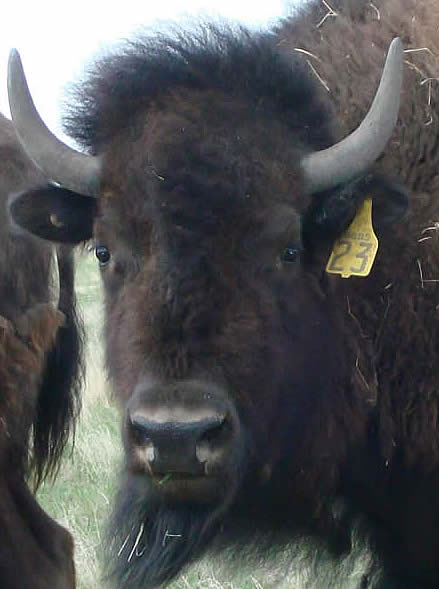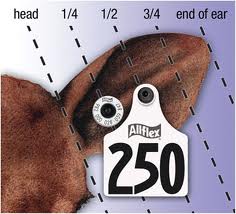Canadian Bison Identification & Traceability
Canadian livestock traceability & bison identification
Traceability in Canada is a collaborative effort involving government (federal, provincial and territorial) and the livestock industry. Livestock traceability is critical for Canada’s ability to respond quickly to disease outbreaks, food safety issues and natural disasters.
Canada’s traceability system is based on the following three pillars:
- Animal Identification
- Premises Identification (A geographical location)
- Animal Movement recording and reporting
Gaps in Canada’s current traceability system were identified through public consultations held by the Canadian Food Inspection Agency in 2013 and 2015. Ongoing efforts to address those gaps are moving forward nationally, and work continues on ensuring all traceability information is accurate, validated and available when needed.
Livestock traceability
Federal, provincial and territorial Ministers of Agriculture committed to phasing in a cost-effective National Agriculture and Food Traceability System, beginning with livestock and poultry, and supported by regulations.
Agriculture and Agri-Food Canada (AAFC) established an Industry-Government Advisory Committee (IGAC) to guide the implementation of Canada’s national livestock traceability system. IGAC includes representation of livestock industry leaders across Canada and throughout the supply chain as well as AAFC, the Canadian Food Inspection Agency (CFIA) and provincial and territorial (PT) governments. Recent priorities at IGAC include communications, premises identification uptake, and regulatory readiness. Governments have already collaborated with IGAC members on premises identification (PID) uptake awareness activities which contributed to increased uptake across species and the supply chain.
The CFIA established a Regulatory Implementation Committee (RIC) to ensure industry and government readiness for roll-out of the proposed traceability regulations. Members of the IGAC (AAFC, PT governments and industry) participate on the RIC and are supportive of the activities and outcomes of the group as they align with those of the IGAC – activities and outcomes that AAFC has committed to investing in.
The Bison identification program
The Canadian Bison Association (CBA) manages the bison traceability program in Canada. The CBA has worked with the Canadian Cattle Identification Agency (CCIA) sine August 2000 to implement the Canadian Bison Association Traceability Program. CCIA provides the bison industry with the data services required for the bison tractability program.
The bison traceability program is based on the three traceability pillars.
- Animal Identification
- Premises Identification (A geographical location)
- Animal Movement recording and reporting
Bison tagging requirements - animal identification
All bison leaving their farm of origin must be tagged with the species approved Radio Frequency Identification (RFID) tag. Bison RFID tags are part of a number sequence allocated to bison (300,000,000 – 304,999,999).
Bison tags are white in colour. It is illegal to tag bison with yellow-coloured RFID tags.
If you are exporting live bison for harvesting, all that is required is the RFID tag.
If you are exporting bison for feeding or breeding, an RFID tag is required plus a companion dangle tag with the same number as the RFID tag, or an RFID tag plus a “CAN” brand on the bison’s right hip or an RFID tag plus a “CAN” bison ear tattoo. It is recommended that exporters check with the destination state as to their requirements as state requirements may vary.
Bison tags can only be purchased from the Canadian Bison Association. Upon ordering tags, they are shipped directly to the producer by Kane Veterinary Supplies in Edmonton, AB.
Canadian Bison Association Tag Options: Click here for document
To order tags click here for an English-Bison Identification Tag Order Form.
Pour commander des balises, cliquez ici ici pour un formulaire d'ordonnance d'identification Français-Bison
Important tagging guidelines for producers
- All bison must be tagged with the approved tag before leaving their farm of origin (unless going to an approved tagging site).
- The bison RFID tags are white in colour – yellow RFID tags are illegal for bison
- The tags should be applied according to the manufacturer's instructions (see pictures below)
- Bison Identification tags should never be reused.
- Records of the ID number of re-tagged animals (i.e.. bison who have lost tags) should be kept along with any known information of where they came from.
- Bison tags may be removed from an animal that is dead because of slaughter or being processed by a renderer.
- Every person who exports an animal shall ensure that the number of the animal’s approved tag is reported to the administrator (CCIA), along with the number of any tag applied to the animal in place of the approved tag, within 30 days after exportation. Click Here for CFIA Export Requirements, etc.
- Improper bison identification can result in unnecessary monetary penalties.


Tag Readers
Now available through the Canadian Bison Association: RFID(EID) tag readers
Maximizing the benefits of RFID technology
Premises Identification
Premises identification is the assignment of a, unique identification number to a physical land location referred to as a premises location.
For more information, or to find a contact in your province or territory, please visit www.inspection.gc.ca/traceability.
Canadian Bison Association would like to update their databases with your Premise ID numbers. Below are the links to the websites for your Premise ID number if you have not yet received one.
https://www.alberta.ca/register-with-the-animal-pr...
http://www.omafra.gov.on.ca/english/food/foodsafet...
https://www2.gov.bc.ca/gov/content/industry/agriculture-seafood/programs/premises-id
https://www.gov.mb.ca/agriculture/food-safety/trac...
https://premisesid.saskatchewan.ca/pid/
Animal movement
Recording animal movement is the reporting on the CCIA data base of any movement of animals in or out of your inventory (CCIA ID profile).
You will always be recognized as the farm of origin for animals born on your premises; however each movement of animals for whatever reason should be documented. This would allow fast and accurate tracking for a faster response to assist producers if an animal health or food safety issue should ever arise.
Here is the
link to the CLTS resource centre website to assist you with this documentation http://support.canadaid.ca/. Recording movement events allows producers to have
documentation of time line in the event of a disease occurrence.
understanding your tagging responsibilities - most frequently asked questions
The bison component of the Livestock Identification and Traceability program incorporates the three key pillars of traceability: 1. Animal Identification, 2. Premises Identification, and 3. Animal Movement. The federal Health of Animals Regulations require that all animals be identified with an approved tag before they leave their farm of origin. Provinces collect location information from producers to have their premises identified for traceability. The Canadian Food Inspection Agency (CFIA) is proposing regulations that are anticipated to be published late 2017 that would require, among other things, additional type of domestic movements being reported.
The Canadian Cattle Identification Agency (CCIA) is the administrator responsible for bison and as such, provides bison producers with database services to assist in managing traceability information. Over the past five years, technology has improved to facilitate data collection and managing traceability information. Web-based access to the CCIA database by producers provides them with the ability to report traceability information. The Canadian Bison Association (CBA) office and CCIA will assist with any questions producers may have.
The bison traceability system begins with ensuring that bison are identified with an approved tag in compliance with regulations. Here are questions and answers that are intended to assist in your current tagging responsibilities.
When do I need to identify bison?
Bison need to be identified with an ear tag approved for bison before leaving their farm of origin.
What tags am I required to use for tagging bison?
The only approved tags available for bison producers are white Radio Frequency Identification (RFID) tags with the specific numbers allocated for bison (300,000,000 to 304,999,999). These tags are specifically approved for bison and bear the Canadian Bison Association logo on the male part of the tag.
Is it legal to identify bison with tags approved for cattle?
No. Bison must be identified with tags approved for bison.
Where can I purchase bison tags?
Bison tags can only be purchased through the Canadian Bison Association (306-522-4766). When tags are ordered they are immediately shipped from Kane Vet Supplies in Edmonton. Rush orders can be shipped at additional cost using a courier or Express Post.
What if I do not have proper equipment to safely tag bison on my farm?
You can move your bison to an approved tagging site to be tagged. You will need to get the approved tags for your bison, and bring them with the animals to the operator of the tagging site. There is a list of approved tagging sites on the CCIA website.
What do I do if I receive bison that are not identified with an approved tag?
You must apply an approved tag to an animal that does not bear an approved tag. You may only apply tags approved for bison and that have been issued to your site.
What if I need to apply a new tag to an animal that already bears an approved tag (in the event the approved tag is not properly functioning)?
You must report the number of the newly approved tag and the number of the previously approved tag to the CCIA website within 30 days of the new tag being applied.
Identifying bison that you export
Exporters, have the responsibility to ensure that the bison that they export bear an approved tag. It is prohibited to remove an approved Canadian tag from an animal that is being exported and/or replace an existing approved tag with another tag (such as the Health of Animals Act tag).
What tags do I need to use for export of live bison to the United States?
If you are exporting finished bison for harvesting in the United States, all that is required is the approved bison RFID tag.
If bison are being exported to the United States for breeding or feeding purposes, an RFID tag is required plus one of the following – a tattoo, a brand on the upper right hip, or a companion RFID white dangle tag that has the same number as the RFID tag. It is important to check with the destination state as some states may require a brand. The RFID/dangle tag combos can be purchased from the CBA.
Who reports the retirement of tags applied to bison or reports the export of bison?
The retirement event is reported to signal that the animal bearing a given approved tag is dead. The operator of abattoirs and rendering plants must retire the tags of animals processed or disposed at their site to the CLTS database administered by CCIA within 30 days.
Persons who export bison are required to report such export to the CLTS within 30 days.
If the bison are already tagged with an RFID tag and I want to export the bison for breeding or feeding, what are my options?
You must retag with another RFID tag and the companion dangle tag. It is illegal to remove and replace approved RFID tags.
If I purchase bison that are not tagged, can I apply tags that I purchased for my farm?
No. The bison must be tagged before they leave the farm of origin (or sent to an approved tagging site) with tags issued to the farm of origin. You can only apply your own tags if you have received a bison without a tag onto your own farm operation.
Do I need to tag bison that are being shipped or can I send the tags with the trucker?
You must tag the bison. The Health of Animals Regulations require that bison be tagged prior to leaving their farm of origin, including those going to community pasture, exhibition site, test station or veterinary clinic (unless going to an approved tagging site). A list of approved tagging sites is available on the CCIA website



